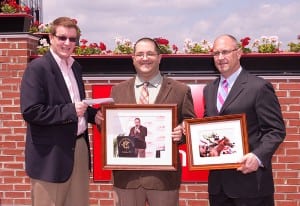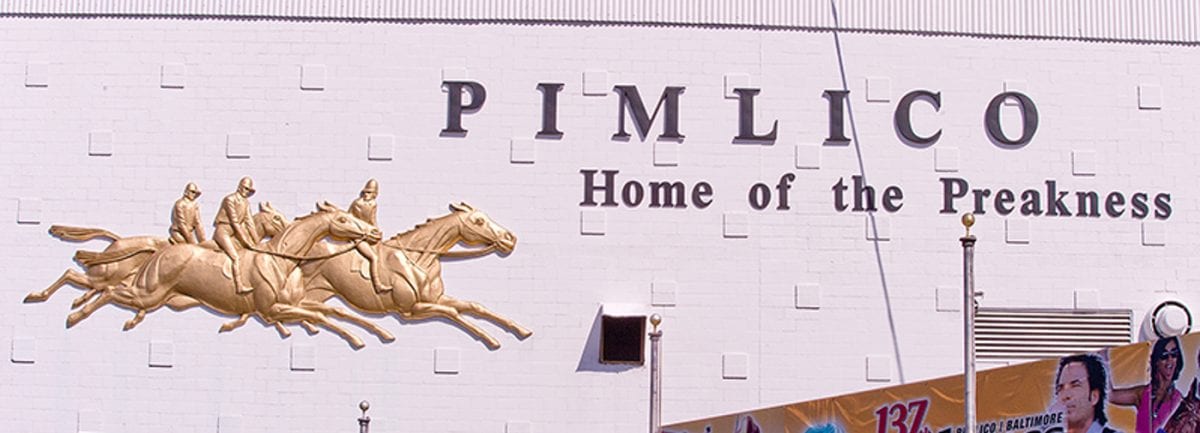by Frank Vespe
The just-completed Pimlico spring meet is likely to be a template for future meetings at Old Hilltop.
If so, that means that live racing until at least the Belmont, events targeted at broadening racing’s audience, and further modest improvements to the aging facility itself will continue to characterize the Baltimore racing scene.
So said Maryland Jockey Club president Tom Chuckas in a phone interview this week following the conclusion of the 2013 Preakness meet.

Maryland Jockey Club president Tom Chuckas (left), pictured with Vice President-Communications Mike Gathagan (right) and former MJC linemaker Frank Carulli. Photo by Jim McCue, Maryland Jockey Club.
With a longer meet this year — 36 days of live racing and 33 simulcast only days, versus 29 and 21 in both 2012 and 2011 — gross handle numbers posted solid gains. Gross handle — including live, import, and export — totaled just shy of $188 million during the stand, up from about $168 million in 2012.
But average numbers were down across the board, primarily, if not entirely, because the added days dilute the relative significance of the Preakness. Nearly $82 million — more than 40 percent of Pimlico’s handle during the stand — was wagered on the Preakness card this year, slightly more than in 2012.
Still, Chuckas characterized the Preakness meet as “an up.” He added, “I’m not disappointed. The final numbers were very close to our internal projections.”
He said that while the MJC had not yet reached a final decision, he believes that “more than likely we will run up to the Belmont” in coming years.
Doing so, he believes will both allow the track to tap into the excitement of the Triple Crown trail — rather than stepping off that trail with a race to go — and can serve as the linchpin for future marketing efforts.
“I’m pleased with what we’ve done,” Chuckas noted. “I think in a year or two, it’ll be a very successful meet after the Preakness.”
[pullquote]”I think in a year or two, it’ll be a very successful meet after the Preakness,” Chuckas said.[/pullquote]In broadest strokes, the plan’s three elements — attracting more people to the track, enticing them to come back, and encouraging them to wager more while there — will work best if done in concert. And though Preakness week is at the heart of the endeavor, it is not alone.
Chuckas pointed to the “Preakness eve” concert in the infield on Black-Eyed Susan day, which bumped attendance for that day to more than 38,000, as one successful new marketing effort.
He also praised the track’s Decanter wine festival and Brew and Bourbon Classic, both held in the second floor grandstand. At the latter, he noted, when he visited early in the day the wagering lines were “10 deep, so we opened three more windows.”
“Both will be a part of our standard program [in the future],” he added. “They bring a very good age demographic and a good mix of male and female.”
Chuckas expects other similar events — perhaps including ethnic festivals — to bolster attendance at Pimlico in coming years.
Convincing those who attend big events to return to the track is another challenge, and the dropoff can be dramatic. This year, for example, handle on the Pimlico live card on the Saturday after the Preakness dropped to shy of $1.9 million, around $80 million less than Preakness day.
One avenue the track will investigate next year, Chuckas said, is a pass of some sort to encourage those who attend the Preakness to return. He also pointed to improvements in customer service and the appearance of the track as tangible elements in making it “more comfortable” for visitors.
“We’re making an effort to capture those people,” he observed, “not just for the day but to get them back.”
Once they enter the doors, of course, the economic health of the sport depends in large measure on their willingness to wager. Chuckas pointed to the track’s success in growing handle in the infield as a harbinger of what he hopes the future will hold.
Infield handle has risen substantially in recent years. Partially, that’s because elimination of the BYOB tradition in the infield has led to a less rowdy, slightly older, and more inclined (and able) to gamble crowd.
[pullquote]”The game has changed on a multitude of levels,” he observed. “If we want to be around in a few years, we’re going to have to adjust and modify.”[/pullquote]At the same time, the track has taken specific steps to encourage fans to wager and educate them about how to do so. Those includes more televisions and an enhanced infield wagering center — features that Chuckas says fans have asked for more of. It also includes the Horse Player Now education events held during Preakness weekend.
As to the future, everyone in racing — Chuckas included — speaks of the necessity of attracting young people to the sport. That, he noted, is an investment with long-term benefits, since most young people don’t wager much. “You’re trying to build a pathway,” he said.
At the same time, Chuckas believes the track can profitably focus on another demographic: ages 55 and up. He expects to hold orientation programs for older people in coming years — a group that might feel comfortable with the older audience already in racing and one that brings considerable disposable income with which to wager. “That helps you in the short term,” he added.
“The game has changed on a multitude of levels,” he observed. “If we want to be around in a few years, we’re going to have to adjust and modify.”








I was impressed to see this article concede that drunken 19 YO’s (mostly white) in an infield are not the key to a solid racing future. In fact drunks make for counterproductive fans at baseball, football, or NASCAR events, but every promotion I see trying to engage new Thoroughbred followers involves alcohol. I can also speak personally to a lack of African-American wagerers at every track I’ve been to in the last 15 years as compared to the 70’s, 80’s or 90’s. The Racino’s, in the Mid Atlantic such as Harrahs Chester, Delaware Park, PARX, Dover Downs have a substantial number of Asian, African American and Hispanic Patrons, but they aren’t wagering on Horses nor does any Jockey Club or Owners Group seem to care, so how did you expect to succeed in growing your base?
thanks for checking in, Charles. I think 1) there’s unfortunately a lack of wagerers of every color and creed compared to 20-40 years ago and 2) I think the possibility of “ethnic festivals,” briefly mentioned in the article, goes to what you’re saying. That said, you’re exactly right – racing has been slow to respond to major demographic shifts in our country in recent decades, and it would help – a lot – if we started to do so now.